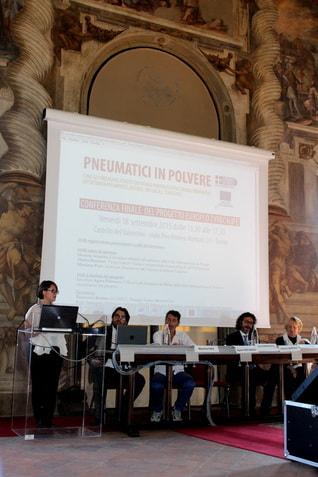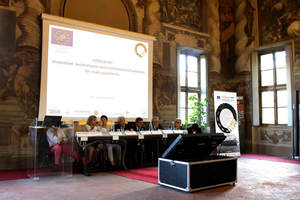|
The Tyrec4Life’s results have been exhibited. The project concerns the use of bitumen containing crumb rubber from scrap tyres. The conference took place at the Castello Valentino in Turin, last Friday, 19th September 2015. The audience was attended by all the project partners: the Metropolitan City of Turin (project leader), Politecnico di Torino, Fiat Research Centre (CRF), Brillada & C. (a road construction company in Piemonte), Patrimonio Città di Settimo Torinese, Ceipiemonte (center for the internationalization of the Piedmont Region).
Tyrec4Life is one of the action plans co-financed by the EU LIFE+ Program, which is dedicated to support "projects that contribute to the development and implementation of environmental policy and law" (LIFE+ Program). According to the guidelines of the LIFE+ Program, the project, which was 3.5 million EUR worth, focused on three macro areas - nature and biodiversity, environmental policy and governance, information and communication – and its results effectively satisfied technical, economic and environmental parameters. Francesco Bonino, LCA & ELV Manager of the CRF, and Prof. Ezio Santagata (DIATI Department - Politecnico di Torino, scientific director of the project) explained the main aspects of the research, emphasizing the benefits and environmental performance of the End of Life Tyres (ELTs) grinded into crumb rubber and demonstrating "the multi-disciplinary nature of the results", as stated by Prof. Santagata. Today it is possible to observe some real improvements in ELTs recovery rates: in 2008, despite the ban imposed by EC Directive 31, 30% of all scrap tyres were disposed in landfill, 45% targeted for recovery and energy, and only 25% for material recovery. Only a few years later, the percentage of ELTs collected and sent forwarded to recycling processes increased to 43% (data of 2013), while the remaining 57% has been converted to energy recovery. Although a considerable stock (which will have to be recovered gradually) remains, the applications are numerous. Eng. Marco Benso, Technical Manager of the Roads Sector for the Metropolitan City of Turin, Marco Sala, responsible for road concession of Patrimonio Città Settimo Torinese, and Vittorio Brillada, President of Brillada Vittorio & C., illustrated them. Several kilometers of paving have already been realized with mixtures of bitumen enriched with crumb rubber from ELTs: the result proved excellent properties of vehicle drainability, adhesion and sound absorption. Another advantage is also represented by the minimization of energy consumption in the phase of production. The are many examples in Italy and in Piedmont: the Borgaro- Venaria road, a part of the road from Baio Dora (Borgofranco of Ivrea), the road for San Giorgio Canavese, and the road for Settimo Torinese, two kilometers length. Innovative technologies have been evaluated in the context of applications of LCA (Life Cycle Assessment), thanks to Prof. Mariachiara Zanetti, Director of the DIATI Department of the Politecnico di Torino, and her team. In this contest, the use of ELT is advantageous both to produce conglomerates for street paving, in line with the objectives set for this sector by the EU, and for the construction of an innovative system of Life Cycle Risk Assessment (LCRA), which takes into account the toxicity parameters (Hazard Quotient HQ) and carcinogenicity (Individual Life Excess Cancer Risk IELCR). A discussion table followed these presentations and addressed the main prospects, employment opportunities and some criteria concerning the recycling of ELTs and its economic sustainability. Paolo Foietta, officer of the TAV Committee, asserted: "It is necessary to translate a positive experience into a process that can be quantitatively significant". It is therefore essential to encourage this market with a concrete assessment of the costs. Roberto Ronco, Regione Piemonte anticipated that "We must use the planning tools to grow the market for ELTs in order to compare the cost of bitumen enriched with scrap crumb rubber, equalizing the traditional one". In conclusion, identifying the uses for ELTs will be very important. And, as Professor Maria Chiara Zanetti pointed out, "The law obliges us to grind the ELTs, then you need to find solutions. As an alternative to road paving, ELTs could be used for athletic tracks or football fields. What is certain is that, if you do not know the possible outlets, the temptation to landfill disposal is strong". Tyrec4Life plays a particularly important role in the dissemination of these findings and, of course, in awareness raising over a very crucial topic. The recycling of ELTs has many applications and this is the reason why we can only agree with what was stated by Agata Fortunato, coordinator of the project and Head of the Office for the Integrated Waste Cycle for the Metropolitan City of Turin: "The extraordinary size offered by the road paving system is an opportunity that has no equals".
0 Comments
Leave a Reply. |
Archives
April 2024
Categories |
Location
|
Contact Us
|



 RSS Feed
RSS Feed